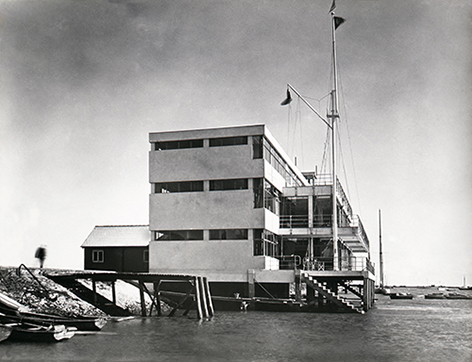Pallant House Gallery, 18 February – 17 May 2015
02 Feb 2015
 The Royal Corinthian Yacht Club, Burnham on Crouch, 1931. Joseph Emberton Archive, University of Brighton Design Archives.
The Royal Corinthian Yacht Club, Burnham on Crouch, 1931. Joseph Emberton Archive, University of Brighton Design Archives.The Joseph Emberton Archive has been part of the University of Brighton Design Archives since 2002. This exhibition for Pallant House, curated by Professor Catherine Moriarty and Design Archives Archivist and Research Fellow, Sue Breakell, showcases items from the collection alongside loans from the RIBA Library to explore the buildings of this significant twentieth-century architect.
In 1937 the Museum of Modern Art, New York, held an exhibition entitled Modern Architecture in England. It included two buildings by Joseph Emberton (1889-1956), the Southsea branch of Timothy Whites, completed in 1934, and the department store Simpson (Piccadilly) Ltd. of 1936. In an essay accompanying the exhibition, the architectural historian Henry-Russell Hitchcock discussed Berthold Lubetkin’s penguin pool at London Zoo, arguing that in providing a setting for an activity it solved an ‘essential functional problem’. This analysis offers a useful approach to Emberton’s buildings and the way in which they were understood as modern. He too, was particularly good at creating settings, often involving viewers and the observed. This skill at display, be it of commodities in a retail or exhibition context, of people shopping, promenading or eating, or of activities related to spectacle, could perhaps sum up the qualities of Emberton’s best structures.
It is this idea that has shaped this exhibition which draws on the rich material in the Joseph Emberton Archive and includes significant loans from the RIBA/Victoria and Albert Museum. Starting with exhibition projects, including kiosks for the British Empire Exhibition, Wembley (1924), and Olympia (1929), it moves on to the structures Emberton designed for leisure: his yacht club at Burnham on Crouch and the fantastic seaside environment of Blackpool Pleasure Beach. It then focuses on the celebrated retail spaces, Simpson (Piccadilly) Ltd., HMV on Oxford Street, and others that are less well known. The final section considers the housing and reconstruction schemes that Emberton designed, including a residential and retail development at Old Street for which his fellow student and friend, Leon Underwood, contributed a sculpture.
Emberton’s buildings demonstrate how the production, appearance and experience of modernity did not always align in an inter-war period characterized as much by convention as innovation. His work was caught between the past and the future – in both its making and its use. In bringing together the ways that Emberton’s buildings were presented - photographically and in watercolour - with the archival context of their production and reception, this exhibition is intended as an invitation to visit the buildings themselves.
Joseph Emberton: the Architecture of Display, Pallant House Gallery, De Longhi print room, 18 February – 17 May 2015.
We are grateful to Jocelyn Underwood and her family for their support and assistance.
Comprising several hundred items, including photography, news cuttings and correspondence, the Joseph Emberton Archive is fully catalogued and searchable online.
An essay ‘Joseph Emberton: The Architecture of Display’ by Catherine Moriarty appears in the Pallant House Magazine, no. 34, 2015.
Emberton was a keen amateur filmmaker and recorded both his family and work. Examples of his films are accessible at Screen Archive South East.
A pack of postcards comprising highlights from the Joseph Emberton Archive is now available.